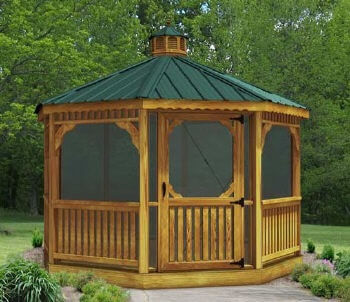Spa Gazebo
For Shade And Privacy
To get the most use out of your spa it should be in a well protected area. A spa gazebo offers just this kind of protection.
Normally a gazebo for your spa has a waterproof roof to keep you dry and side panels to offer protection from the wind. Not only do these gazebos make your spa time more enjoyable they also protect your valuable investment. These are typically designed to be spacious enough to accommodate the size of the spa or hot tub, while providing cover from outdoor elements such as sun, rain, or snow. They often have special features like adjustable louvers or windows for privacy, some even come with space to hang robes or towels.

Another added benefit from a gazebo covering your spa area is the beauty it can add to your yard. Wood and Vinyl gazebos will both add a strong vocal point to any backyard paradise.
Other material choices to consider would be aluminum, typically used on more modern gazebo styles. It's light, durable and resistant to rust and corrosion.
Steel is made to last, this heavy-duty material is often physically larger and requires more support structures. They provide excellent durability. Polycarbonate is a popular choice for the roof of the gazebo to allow light through while protecting from UV rays, rain and snow. Glass is used in some designs, tempered glass may be used for walls or windows for added aesthetic appeal, protection and visibility.
Choosing the right material largely depends on your aesthetic preferences, budget, and the climate in your area.
Of course you want to know where to buy one, so here are my top picks.
- Amazon: As one of the largest online marketplaces, Amazon offers a variety of spa gazebos from different brands with customer reviews that you can read before making a purchase.
- Home Depot: This American home improvement retailer provides an array of outdoor structures, including gazebos designed for spas or hot tubs.
- Lowe's: Similar to Home Depot, Lowe's offers a range of options you can either order online or pick up in store.
- Wayfair: An online retailer specializing in home goods where you can find a diversity of gazebos tailored to cover spas.
- Costco: If you are a member, you can buy a spa gazebo at Costco. They offer a variety of designs and sizes.
- Alibaba: If you're looking for wholesale options, Alibaba is a good place. You can connect directly with manufacturers, providing for a potentially less expensive option, especially for larger orders.
- Overstock: This online retailer offers a wide range of products, including spa gazebos, often at discounted prices.
Whether or not you can set up a spa gazebo yourself depends largely on the complexity of the gazebo, your skills, and your level of experience with do-it-yourself (DIY) projects. Some gazebo kits are designed to be DIY-friendly and come with all the necessary pieces and instructions for assembly. These types of kits are typically meant for simpler gazebos.
Complex or larger gazebos, particularly those made of heavy materials such as wood or metal, may require more than one person or the skills of a professional for proper and safe installation. Additionally, some gazebo installations might need basic knowledge of wiring (for gazebos with lights, for instance) or may require concrete to secure the gazebo to the ground.
If you’re not confident in your DIY skills or if the project seems too complex, there’s no harm in hiring a handyman or a contractor. Safety should be the utmost priority.